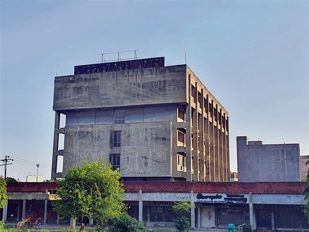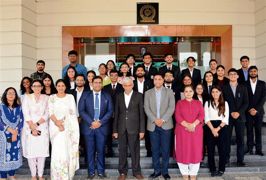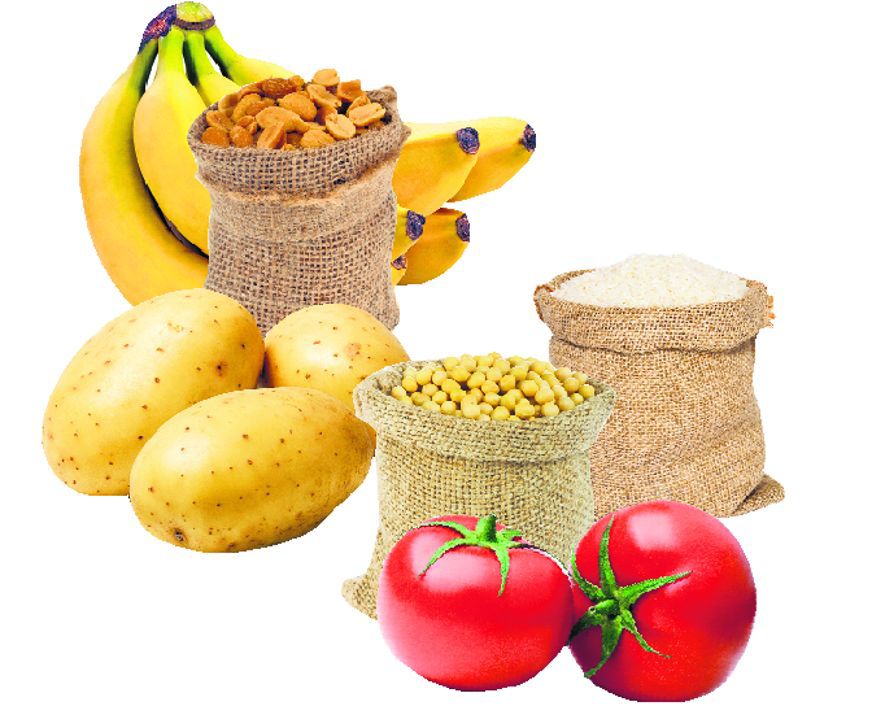
INDIA’s farmers, unlike producers in other sectors, lack direct market linkages and have no active role to play in agricultural commodity value chains despite their crucial contribution to the country’s food and nutritional security.
A. Amarender Reddy and Tulsi Lingareddy
INDIA’s farmers, unlike producers in other sectors, lack direct market linkages and have no active role to play in agricultural commodity value chains despite their crucial contribution to the country’s food and nutritional security. The majority of the farmers still sell their produce at the farmgate due to lack of access to markets, storage and logistics. The average density of regulated wholesale markets in the country is over 450 square kilometres (sq km) against the optimal density of around 80 sq km, as recommended by the National Commission on Farmers, 2004. As a result, most of the small and marginal farmers don’t find it economical to transport their limited quantities of produce to distant regulated markets. Hence, they sell it at the farmgate to market intermediaries, thereby losing their bargaining power to demand a remunerative price. Consequently, farmers remain disconnected from the commodity value chains and continue to receive a low share of the consumer rupee.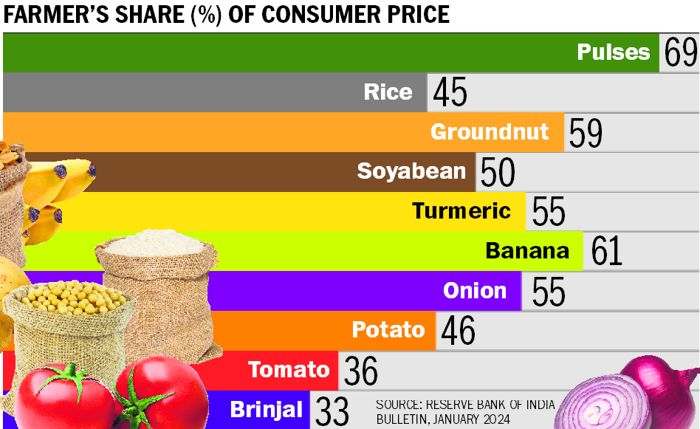
The average share of farmer producers in the consumer rupee, even in commodities with limited processing requirement like foodgrains, is limited to the range of 45-69 per cent, according to a study published in the Reserve Bank of India Bulletin (January 2024). The share falls to 30-40 per cent in the case of perishable commodities like fruits and vegetables. Enabling farmers’ direct linkages with agricultural commodity value chains can benefit them in two ways — increase their share in the consumer rupee through reduced market intermediaries, and help them gain information on the changing consumer demand and quality preferences, thereby aligning their crop production practices accordingly. The advances in digital or electronic commerce (e-commerce) can play a catalytic role by establishing direct market linkages between farmers and agricultural commodity value chain participants like processors, traders and exporters.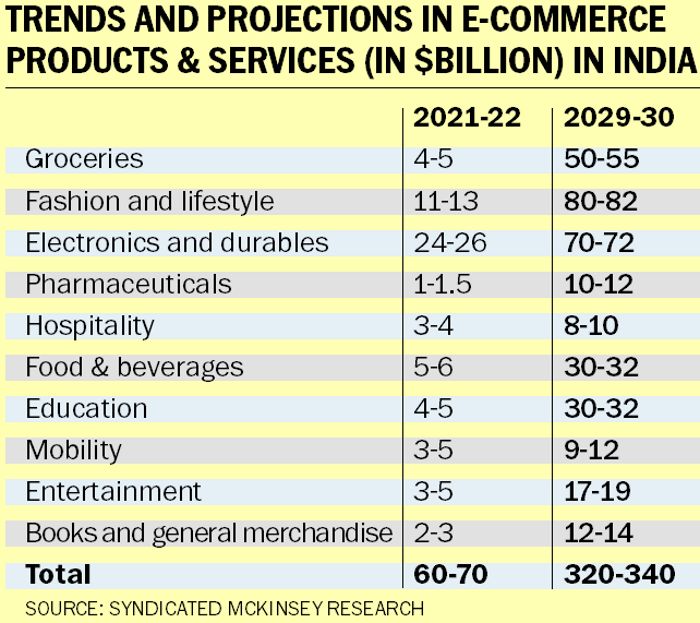
In simple terms, e-commerce is buying and selling of goods and services through electronic platforms or markets. The widespread penetration of the mobile network and the Internet across the country has enabled the outreach of e-commerce over the past two decades. The supply chain disruptions during the Covid-19 pandemic accelerated the use of e-commerce not only in India but also in global merchandise trade. Consequently, the e-commerce market increased rapidly and reached about 20 per cent of the total global sales in 2021. It is expected to reach about 25 per cent by 2025, according to McKinsey & Company. The Indian e-commerce market has also risen rapidly, registering a compound annual growth rate of about 27 per cent in the past five years. It is expected to reach $350 billion by 2030, as estimated by the India Brand Equity Foundation, Department of Commerce, Ministry of Commerce and Industry.
Primarily, there are two types of e-commerce models: marketplace model and inventory-based model. A marketplace business model simply provides a platform to connect buyers and sellers for a commission on every transaction, while the other involves producing or procuring an inventory and selling on own e-commerce platforms. The majority of growth in the e-commerce industry is driven by the marketplace model. However, setting up one’s own platform requires a significant amount of investment, making it less profitable for small and medium businesses to benefit from e-commerce due to lack of economies of scale. In order to provide a level playing field, the Open Network for Digital Commerce (ONDC), a not-for-profit company, was incorporated in December 2021. It was an initiative of the Department for Promotion of Industry and Internal Trade, with commitments from banks and other institutions in the financial services industry.
The ONDC is based on the open-source methodology and is different from the existing e-commerce models that are dependent on specific platform and technology. Similar to the Unified Payment Interface (UPI) for digital payments, the ONDC is expected to make digital commerce access equitable to all enterprises and individuals in the country, particularly to small and medium enterprises, including farmer producer organisations (FPOs). Apart from being sellers, farmers can also register as buyers for purchasing inputs, farm machinery, technology and information services, availing logistics and institutional credit. Recent reports on the ONDC portal suggest significant progress in onboarding FPOs, with over 5,000 FPOs as sellers offering more than 3,100 products till March this year.
While e-commerce provides direct access to markets, the majority of the existing physical market still persists. What is worrisome, particularly for small farmers and traders, is the lack of awareness and technical knowhow of using digital technologies for buying and selling. Poor availability and access to requisite information and communication technology (ICT) infrastructure in rural areas is another major hurdle.
In order to sell through e-commerce, sellers need to provide assurance both of quality and quantity. Farmers require facilities for assaying, grading, standardisation, packaging and certification of the produce. The creation of these facilities requires additional investment and may not be affordable for small farmers, even through FPOs. Only one-third of the markets have grading facilities; electronic weigh bridges are available only in a few markets, according to a policy paper by the National Bank for Agriculture and Rural Development (NABARD).
Another major challenge faced by farmers is the lack of adequate and affordable regulated warehousing facilities. The total warehousing capacity under various agencies in the country is about 201 million tonnes as of March 2023, according to data published by the Warehousing Development and Regulatory Authority. The demand for agricultural storage is projected to be 436 million tonnes by 2024-25.
Almost all these physical market challenges are also constraining participation in the electronic national agricultural market (eNAM). In order to ensure widespread participation of farmers in the ONDC or the eNAM network, it is a must to provide basic infrastructure and logistics. It is essential to develop and upgrade Gramin Agricultural Markets (GrAMs) in villages with adequate market infrastructure facilities for ensuring quality standards and certification along with requisite regulated storage.
The Agricultural Market Infrastructure Fund, set up with NABARD to develop infrastructure and storage in 10,000 GrAMs and 585 APMCs in 2019 with a Rs 2,000-crore corpus, needs to be enhanced. Adequate awareness needs to be raised among farmers about using e-commerce applications.
Reddy is Joint Director, School of Crop Health Policy Support Research, ICAR-National Institute of Biotic Stress Management, Raipur; Lingareddy is a senior economist (financial markets, sustainable finance and agriculture), based in Mumbai. Views are personal
Join Whatsapp Channel of The Tribune for latest updates.





















